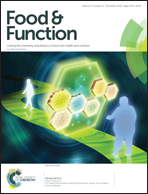Blueberry, combined with probiotics, alleviates non-alcoholic fatty liver disease via IL-22-mediated JAK1/STAT3/BAX signaling†
Abstract
Non-alcoholic fatty liver disease (NAFLD) is one of the most prevalent diseases worldwide. Blueberry, combined with probiotics (BP), might be a potential candidate for NAFLD treatment, due to its anti-inflammatory and anti-apoptotic properties. Here, we investigated whether the anti-inflammatory cytokine, IL-22, was involved in the therapeutic process of BP, using cell and rat models of NAFLD. Results indicated that BP significantly reduced lipid droplets and triglyceride (TG) accumulation in NAFLD cells. However, when IL-22 was deficient, the lipid droplets and TG content were significantly increased. In vivo, the serum parameters and pathological degree of NAFLD rats were significantly improved by BP, while IL-22 silencing significantly abolished the BP effect. Immunohistochemistry, immunofluorescence, qRT-PCR, and western blotting showed that the NAFLD group expressed significantly lower levels of IL-22, JAK1, and STAT3, and higher levels of BAX, than the normal group. Furthermore, BP significantly elevated the levels of IL-22, JAK1 and STAT3, and reduced the level of BAX in NAFLD, while IL-22 silencing prevented BP from restoring the expression of JAK1, STAT3, and BAX. We conclude that IL-22 is vital for the therapeutic effect of BP, and acts via activation of JAK1/STAT3 signaling and inhibition of the apoptosis factor BAX, which makes IL-22 a promising target for therapy of NAFLD.



 Please wait while we load your content...
Please wait while we load your content...